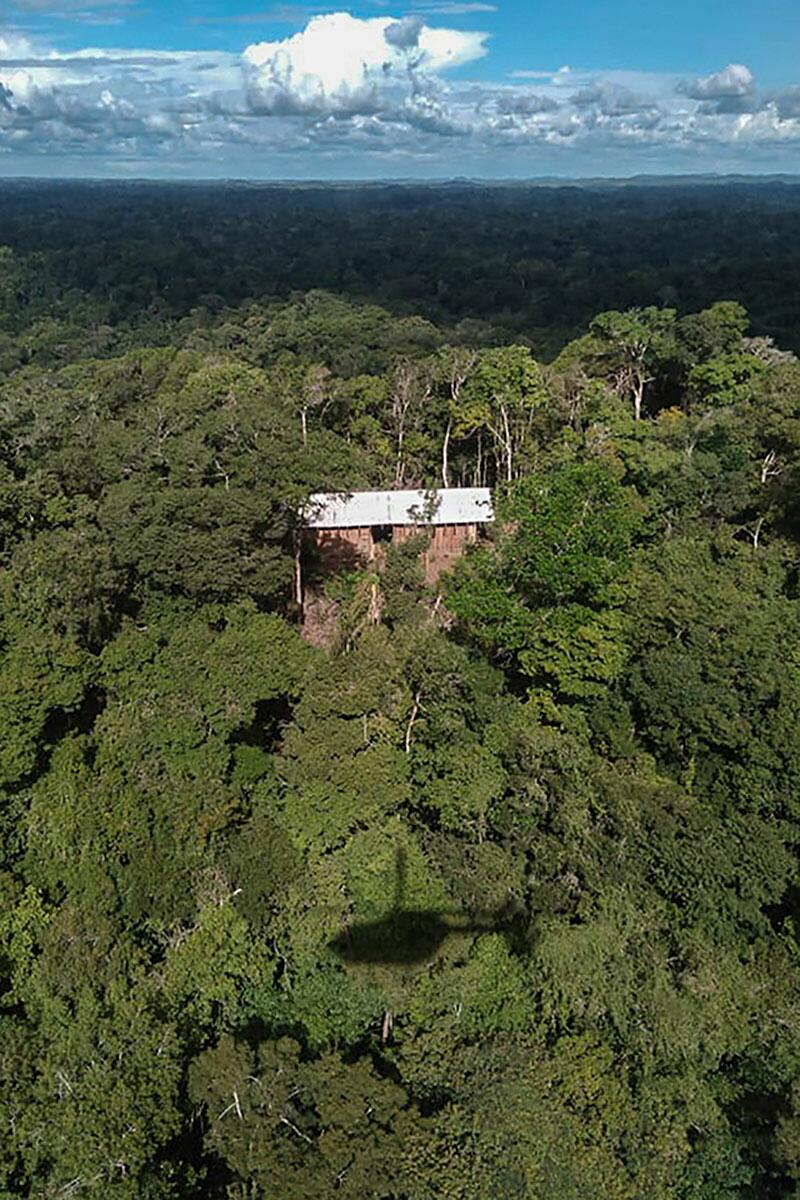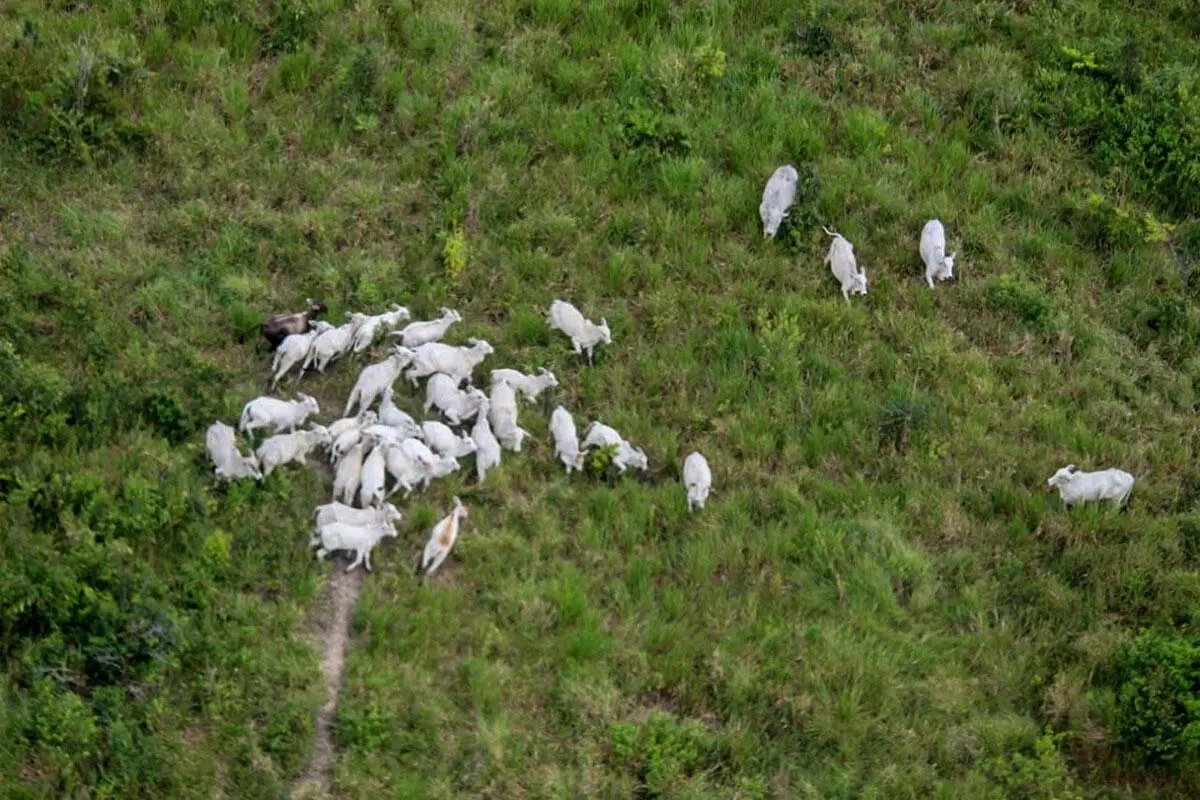The only thing that’s true is the rainforest is being killed. After jotting this down in my notebook I walk through the streets of Auzilândia, a town inhabited by a handful of people who seem to have been isolated by the noise and pollution of a mining train. This place also used to be jungle and now it is a spot that seems to be made of heat and rubble: scrawny looking palm trees; a few white cows – peaceful and diabolical, poor animals, eating the pasture that remains among the dry earth that has been turned over; men, women and children forgotten next to businesses that are becoming more prosperous with every passing day: soybean farms, cattle ranches and mining operations.
Here where I am in the State of Maranhão in Brazil’s northeastern region, where 80 percent of the forest is gone. That means a lot of things, but first and foremost the remaining 20 percent still breathes, beats, dreams, creates and exists. Beautiful, fierce and overwhelming. Full of leaves, vines, roots, fungi, feathers, scales, skin, fangs, stings, perfume, buzzing, thickets and sweat; and songs, screams, blood, heartbeats and eyes.
The living jungle is in terminal danger. Meanwhle the post-truth that is causing it to disappear announces exports and dollars by the bucketload, even as it worsens poverty and violence.
Three hundred and fifty kilometers separate Auzilândia from the State capital of São Luís, an island that often finds itself flooded because, during its construction, a huge swathe of shoreline was covered with cement. The city is home to one of the most important ports in South America – and it is here they bring crops from the fields that used to be jungle, passing colonial shacks that are falling apart. As the trucks rattle past, some of the soybeans fall from the back, on their way to China to feed factory-farmed pigs. At the side of the road, whole families stand out in the scorching heat with brooms and bags to sweep up the grains, collect them and take them home to eat.
It is the agribusiness sector that runs the show in Maranhão. It owns most of the legislative caucuses, the supermarkets, the shopping malls and the media. It is backed up by militias (armed groups) as well as other local gangs and criminal organisations from the States of São Paulo and Mato Grosso, the United States and Argentina. Powerful networks that cover up the destruction of the jungle and its many lives with the force of fire and bulldozers.
As I write it is September 11th and Antônio Cafeteiro Silva Guajajara, who lived in the Araribóia Indigenous Land, has just been shot dead. He was the third of his ethnic group to be killed in the last ten days.
These men who are now dead were part of the indigenous Guardians of the Jungle. They watch over and defend the 20 percent of the forest that remains. They resist. Some die because what is happening here and in the rest of the planet is a war not of one country against another but one of rural business and corporations against nature and therefore against those who live in nature. A war for the dominion and control of the earth, of its living forces and living kingdoms, which in Excel spreadsheets are simply called “resources”. For the ownership of every tree made into wood, every buried mineral made into metal, every square meter of land emptied of animals, flowers, fruits and languages. Emptied of itself, destroyed, and then ready to produce.
When you google the word Maranhão two things pop up: the voices of the economists for whom this productive model seems a success and Lençóis Maranhenses, a desert of white dunes that floods with rain for three months a year, forming green and blue lagoons with tiny adorable fish. Tourists come to this desert land, the only territory that survives the greed that consumes trees, animals and people but they have no knowledge whatsoever of the rest of the State. They are not aware of the jungle that has been destroyed nor the living jungle with its indigenous peoples.
The Awa Guajá people live in this jungle that is watched. Some 520 men and women who, despite everything, protect themselves (and us) from extinction. Since the 1970s they have been forced into contact with the white world and have been living in four villages on the banks of mighty rivers, among huge trees and monkeys, tortoises, snakes, spiders, flowers, butterflies and invaders.
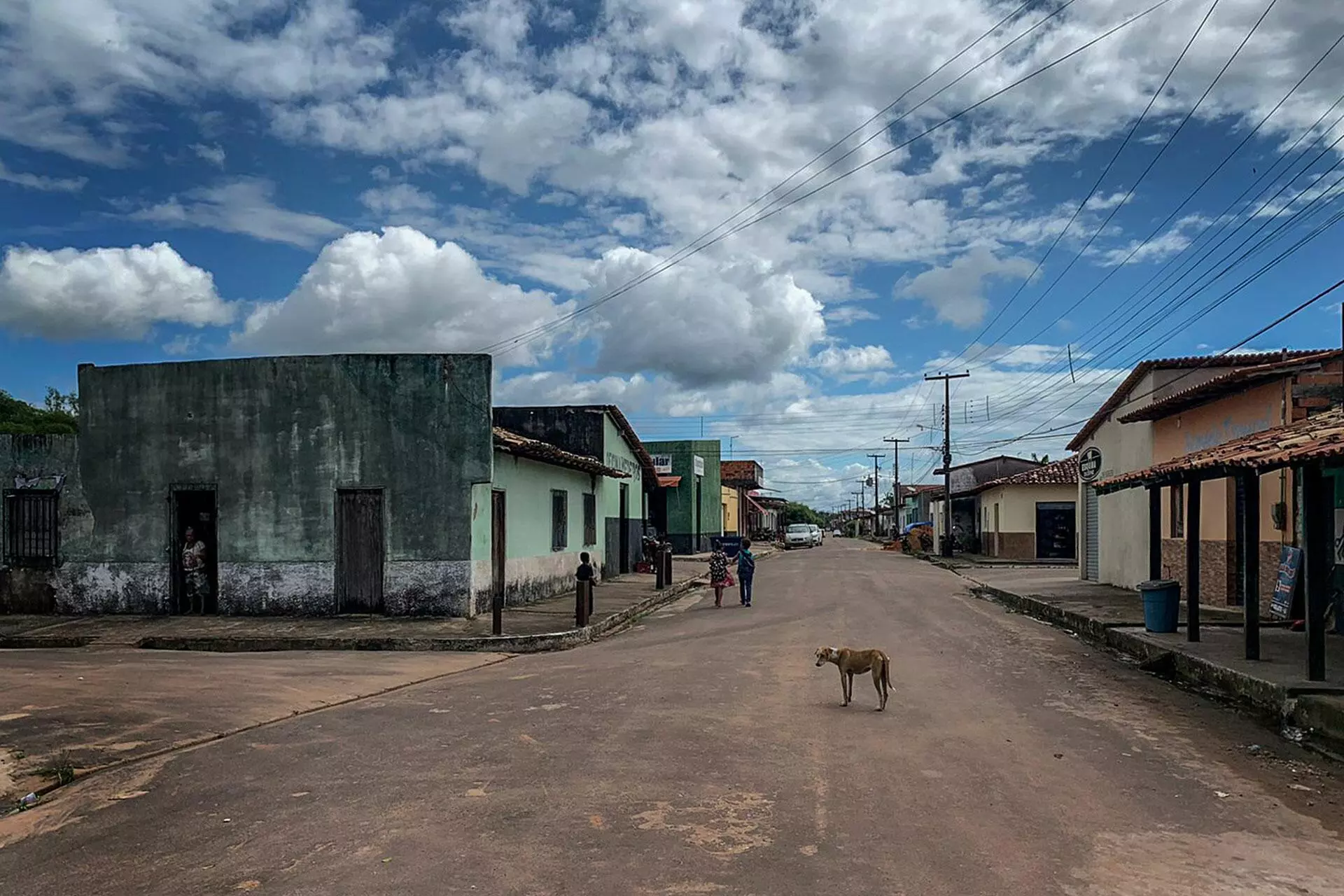
Entrance to the Auzilândia rural community. Photo: Soledad Barruti
Maranhão is a huge state. The routes to get inland are almost impossible. You can drive for hours with no guarantee of reaching your destination. For this reason, the safest way to travel is to take the mining company Vale’s train. Vale first arrived here about 50 years ago during Brazil’s dictatorship period with a mission of order and progress that translated into a lot of fatalities and deforestation. With the Vale train, came men who nowadays call themselves businessmen, but who, for the most part, obtained their property deeds by grabbing land that was indigenous land and killing most of the people who used to live here. Ever since then, this train has been running through the jungle, paving the way for diseases and hired killers. It spreads toxic dust residue and disrupts the lives of 130 villages and communities
I catch the train at 7 a.m. at Anjo da Guarda (Guardian Angel) station, on the outskirts of São Luís. The train is full, clean and the air conditioning is going full blast. The sealed windows sweat the heat outside and droplets of moisture hide the chilling images of the endangered jungle: fallen trees, herds of cows and thousands of red iron freight cars stationed at the side of the track. Although there is a passenger service that runs three times a week, the purpose of the 10,756 railway wagons and 217 locomotives that cover 900 kilometers every day is still the same as when it was first founded: to transport what is extracted from the largest open-pit iron ore mine in the world, Carajás, in the neighboring state of Pará, to the port of São Luís. From there it mostly goes to China.
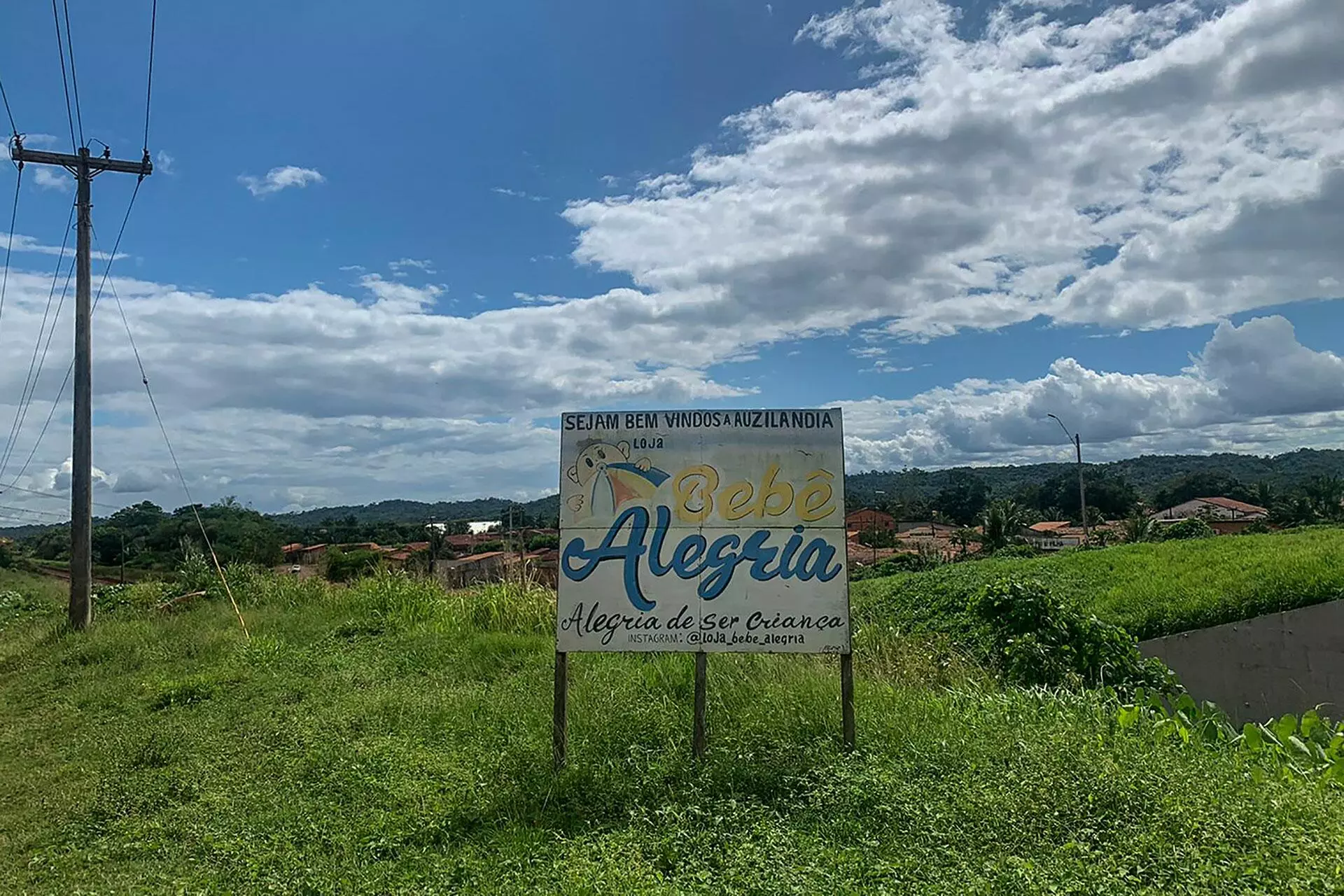
Entrance to the Auzilândia rural community. Photo: Soledad Barruti
My fellow travelers are all silent. They are workers, grandparents and families carrying loads of stuff. Every now and then they open a package of food, look out the window, or take a peep at the TV sets that are showing the children’s movie Alvin and the Chipmunks visit the jungle at full volume.
I travel for five hours to Alto Alegre do Pindaré, a town which is a stopover en-route to my final destination in Indigenous land.
The itinerary and meeting with the Awa Guajá was only possible thanks to the help of Inês, whose name is not actually this, but I cannot give any more details because it would put her at risk. Defending indigenous people while Jair Bolsonaro is president is a dangerous thing to do, even for those who are in official positions. This was the case with Bruno Pereira, who was part of Funai (the National Indian Foundation) who was murdered this year in Vale do Javari along with the English journalist Dom Phillips.
Alto Alegre do Pindaré station stands on an elevated mound surrounded by grass. There are skinny horses, skinny dogs and black crows flying overhead. The heat is humid and it is sticky.
The village consists of small, simple houses and a center of about five blocks that sells cheap clothes and knick-knacks. A lot of the houses have colorful birds in tiny cages as well as flower beds and motorcycles. There is nothing even slightly touristy here, but this town has about ten hotels for Vale workers.
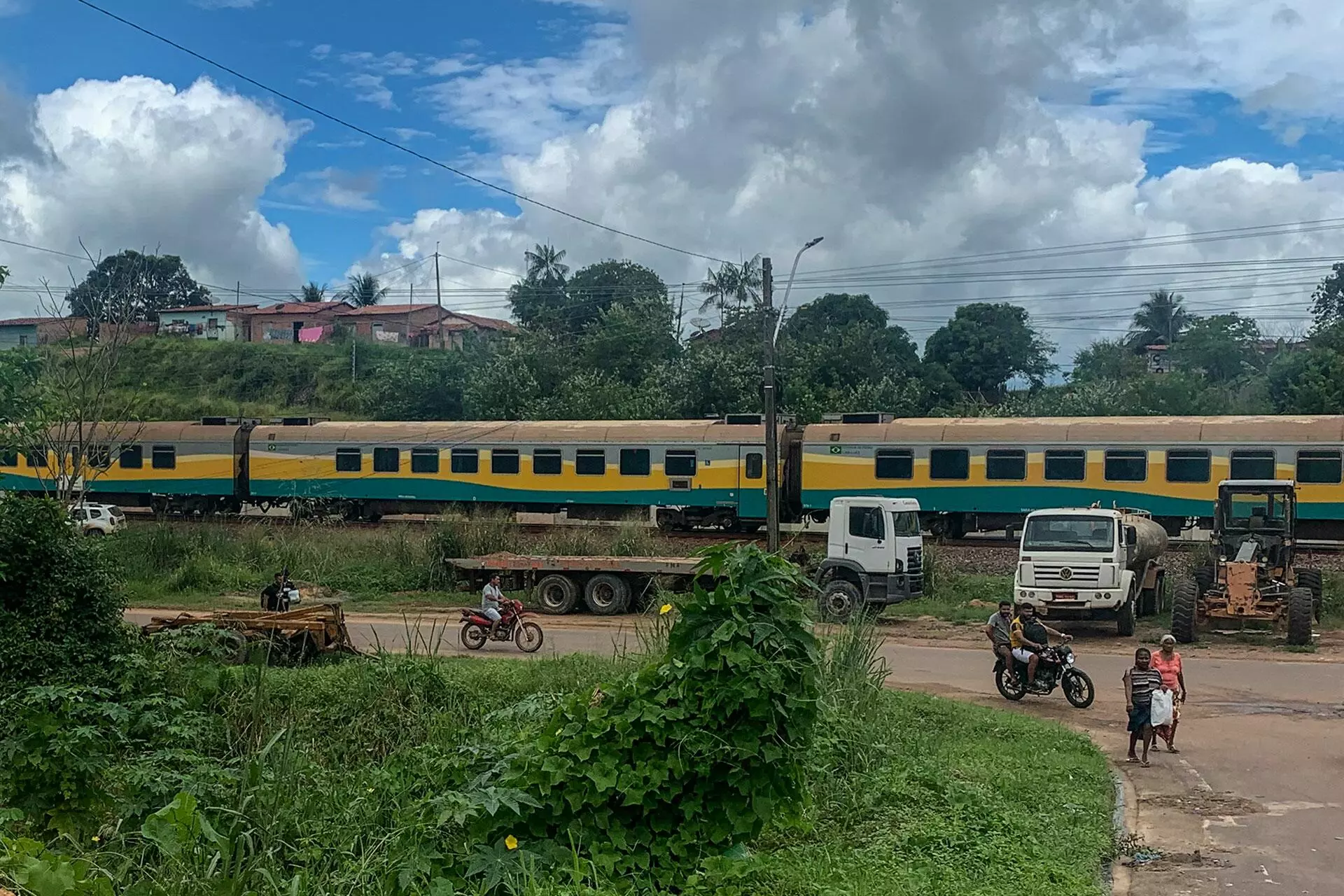
Train station at Alto Alegre do Pindaré, a rural town. Photo: Soledad Barruti
The company, which just in 2021 generated 24 billion reais more than the GDP of the entire state of Maranhão (121 billion versus 97 billion, according to the latest official figures), brings all of its workers in from other places. They are young men and women who throng through the town dressed in gray and blue jumpsuits, as they flit between per-kilo restaurants and local stores.
I get a room at the Betsan Hotel which is just a block of cement in front of the village’s main square. Hanging under an arch, in the sunshine, there’s a caged bird singing. The hotel has 8 modest rooms which for the most part are occupied by Vale’s employees. According to Karen, the receptionist, I’m an unusual guest. “It’s very funny to have you here,” she says.
Maicon — who is going to be my driver — is in another room. He is a bright and solidly built 36-year-old father of two kids that he has left back in São Luís for these few days. Maicon was also an outsourced Vale worker and used to drive their trucks around the country, but nowadays he is a driver for Fetaema, the federation that represents 7,000 rural workers in Maranhão, peasants who are always under threat.
I met Maicon thanks to Diogo Cabral, who is the federation’s lawyer and knows more about the conflicts in these lands than anyone else. Their day-to-day life is always together: Maicon drives thousands of kilometers so that Diogo can get to those who want to stay in the forest, on the river, in the living countryside and who for this reason are in danger. Diogo is 38 years old, with eyes the color of the river, whose roots are in the indigenous Tapuio people, and who has a soft way of speaking that contrasts with the intensity of his work. He and Inês are people who restore hope. Maicon too: he is sensitive, curious and believes that a better world could emerge at any moment.
Traveling with their help is like having a lucky charm.
I am the only foreigner in Alto Alegre and the locals think I am exotic. They point at me, ask for pictures and invite me to have a chat. It seems like a quiet place.
“But I don’t want you to be too trusting,” says Maicon as we eat some of the only food that they sell here: beans, rice, tomato and lettuce salad, some meat, fish and pork tripe. There is also prostitution along with robberies and drugs. There are a lot of people from outside, alone and looking for fun.
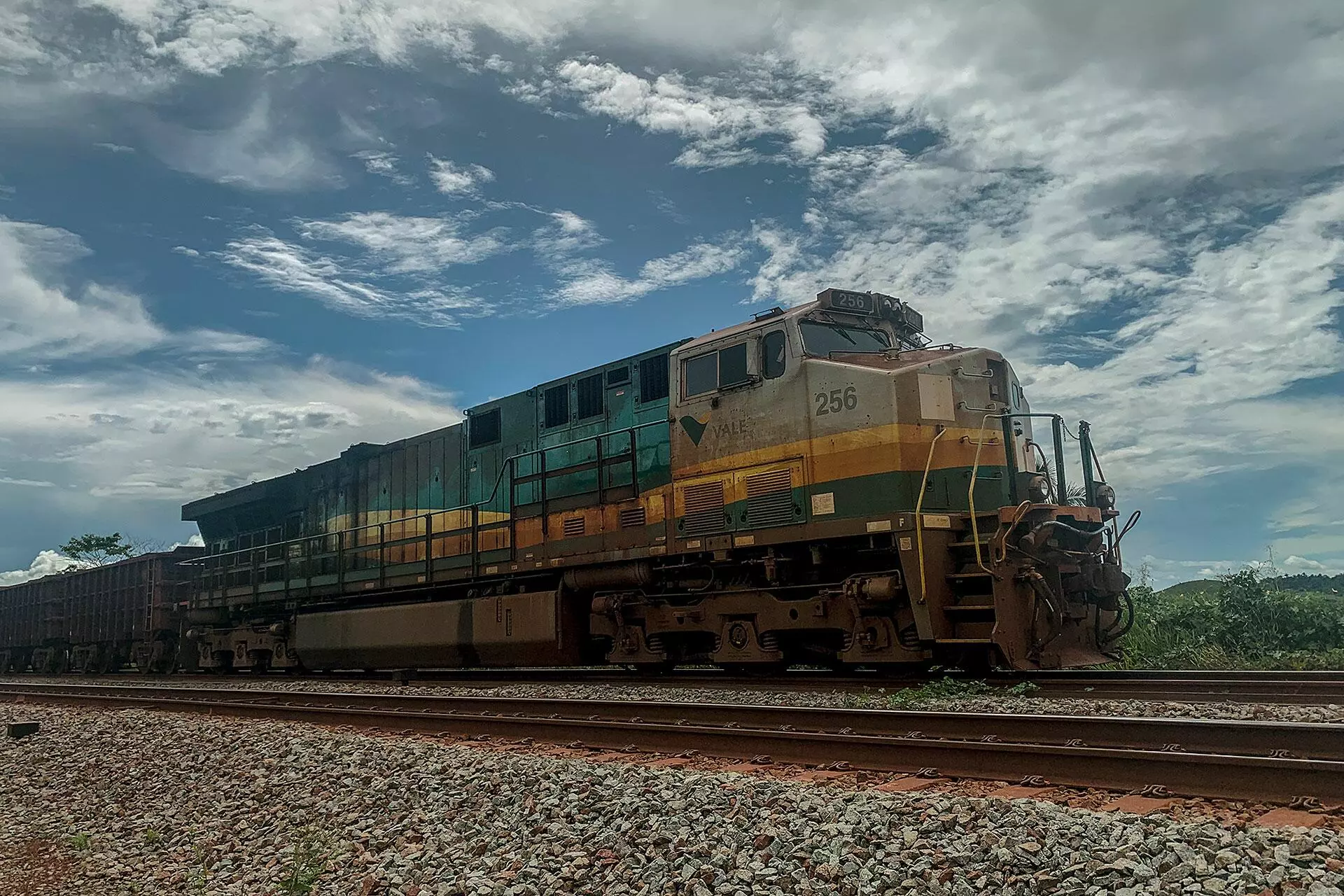
The train of the world’s largest iron ore mine, Carajás. Photo: Soledad Barruti
The first time I spoke with the Awa Guajá people was during the pandemic, when they decided to come out and publicly accuse the government on account of its lack of action in the face of Covid-19. I found a number of things about them fascinating. For example: they are hunter gatherers, they have practices of inter-species relations such as breastfeeding the young of different animals that they adopt as another child until they are fully grown. Also, they are our contemporaries and yet they eat, breed and live in such a radically different way. They have uncontacted relatives numbering roughly 100 people who live in the jungle without any links whatsoever to the white world. Furthermore, those who we came into contact with recently, in other words, those who were forced to leave and negotiate with “our” world, look after them while they take care of themselves and of the jungle for everyone.
In recent years the Awa Guajá have organized themselves internally and set up leaders. They got hold of some motorcycles and quad bikes to move around faster, and cell phones in order to call for help, although their numbers change frequently due to lack of payment. They built guard houses at the highest points in the jungle and demanded an education system that could quickly teach them the language in which their death sentence, Portuguese, is written over and over again.
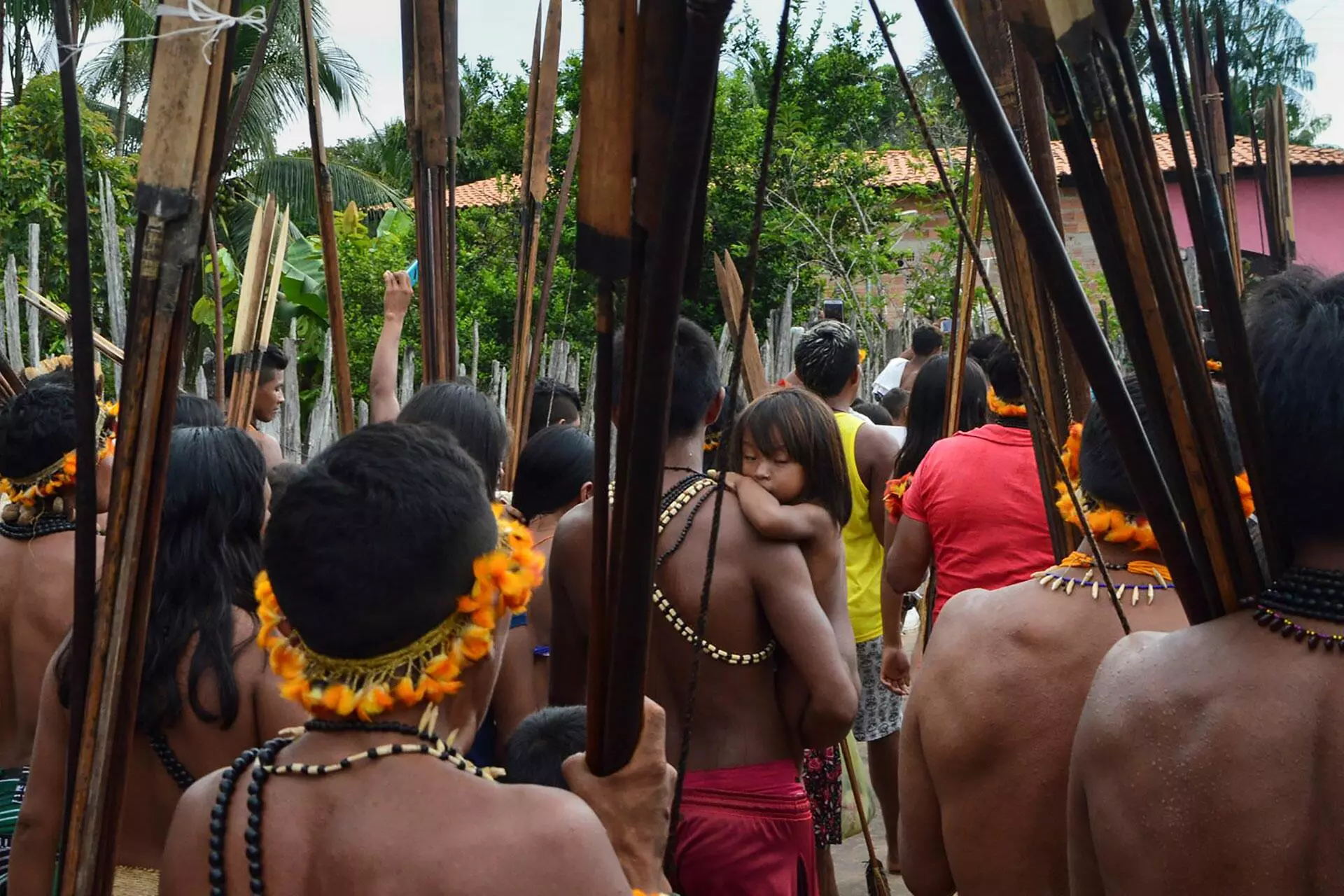
Awa Guajá people at a protest demanding that the education system guarantee their rights. Photo: Awa Guajá archive
The school turned out to be a place of conflict. Despite the legislation and rules that guarantee differentiated, specific, bilingual, intercultural and community education, these guidelines are not respected. The Awa Guajá asked to learn how the State works and what rights they have as well as to record their own culture before their elders die, but now they understand the education system does not shape citizens or people who are capable of this. Except for the will of a few teachers who have decided to accompany them with love and care, the educational system is another bulldozer. All of their proposals are denied: learning in the jungle, having indigenous teachers, learning about our world without losing their own. This year, ten non-indigenous teachers who have not received any training have entered their schools. And the State has no plans to provide training courses for teachers.
For this reason, many of the Awa Guajá are becoming teachers in their villages and have been encouraged to visit São Luís to perform their rituals. Showing and including themselves, recognizing themselves in the eyes and stories of others: that is also what they want so as not to disappear.
Months later, after those long-distance interviews, I suggested the possibility of visiting them. The answer was enthusiastic because they wanted to talk and to have someone listen to them. I then took the appropriate steps: I requested permission from Funai, but within a few hours it was denied. Inês proposed an alternative: we could meet at the entrance to the village, on the riverbank.
It was two days before the meeting and Tatuxa’a, one of the leaders, sent me a photo that had been taken with a drone. It showed that the ranchers had carved out a field in the middle of the jungle, on the Araribóia indigenous land where his relatives live. The image shows cows grazing in a huge opening in the trees, as if a bomb had been dropped.
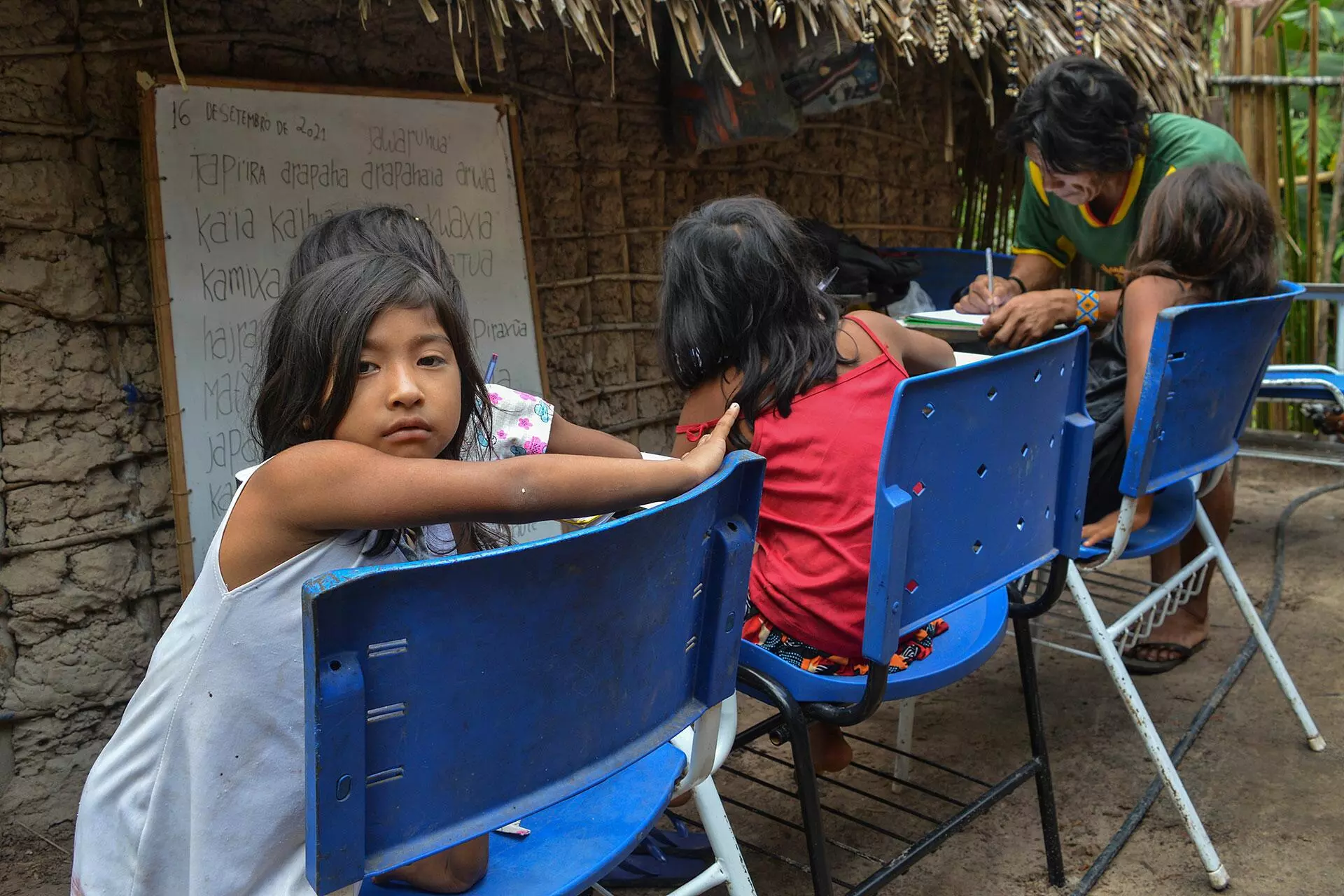
School on Caru indigenous land: a space requested by the indigenous people in order for them to be able to learn the Portuguese language and develop strategies to defend themselves from subservience to the State. Photo: Awa Guajá archive
“We are afraid. The invaders are everywhere. We found a lot of dead game and trees that had been cut down. And now this. It is very serious,” says Tatuxa’a.
Without the forest there is no oxygen, no food or medicine. Without the forest, the web woven by biodiversity comes apart, potentially unleashing pandemics. Without the forest there is less rain: the trees that make the State of Amazonas respire 20 million tons of evaporation every day that become rivers traveling between winds and clouds across South America. Without the forest there is nothing.
That is how serious it is.
I share the photo with Diogo and he shares the statistics with me: according to his group, between January 1st and July 31st, 2022, three peasant leaders were murdered in the forest, one-hundred and eighteen people received direct threats and there were 183 land conflicts, including evictions and invasions.
“In Maranhão there is a permit to practice how to get to the end of the world faster, and that is why this is a threat to the entire human race,” Diogo says.
Ten fresh chickens, three large watermelons, five kilos of bananas, two large drums of water, glasses, a flare gun, matches, a knife, napkins. Maicon buys the things that we have to take with us to the meeting with the Awa people, and I go down to the Pindaré river.
The sky is full of blue-gray clouds. When the sun comes out, it burns the skin. The center of town is deserted. From the houses come the sounds and smells of family lunches. The street is empty except for a long line of people waiting to eat the food prepared by Fetaema, the organization where Diogo and Maicon work, for the price of 1 real (20 cents). Peasant agriculture against the hunger that continues to grow in Brazil: 33 million people have to endure it every day.
The river is bright and calm, like a snake that’s asleep. Deep and the color of silver. A creature that sustains the earth and receives its destruction in the form of ever thicker layers of sediment because without trees the shores collapse, the river becomes wider and loses its vitality and nutrients, until it becomes an empty body of spilled water.
I sit on the sand next to some small trees. It smells like rain. A lady, Regina, approaches me. She is sixty-two years old, but seems older, with copper colored hair tied up with a hairclip, a red skirt and a light blue apron on top. She speaks with a high-pitched, squeaky voice: “Where are you from, what are you doing here, so far away, so pretty, it’s so nice that you are interested in this place. Can I take your picture, they won’t believe me. Let me know if you need anything”.
“I would like to take a tour down the river. Do you know anyone who can take me?” I say to her, and she stands there and she yells out: “Neto, Neto, come here”.
Then two men appeared. The first one Neto, tall and scrawny with skin that looks paper thin. The second one, with gray hair and more heavily built, lifts up his shirt to scratch his belly and reveals an old pistol with a white handle that he strokes like it were a fierce dog.
“We don’t often see outsiders around here,” he says. And then he gets up and goes off without waiting for me to answer.
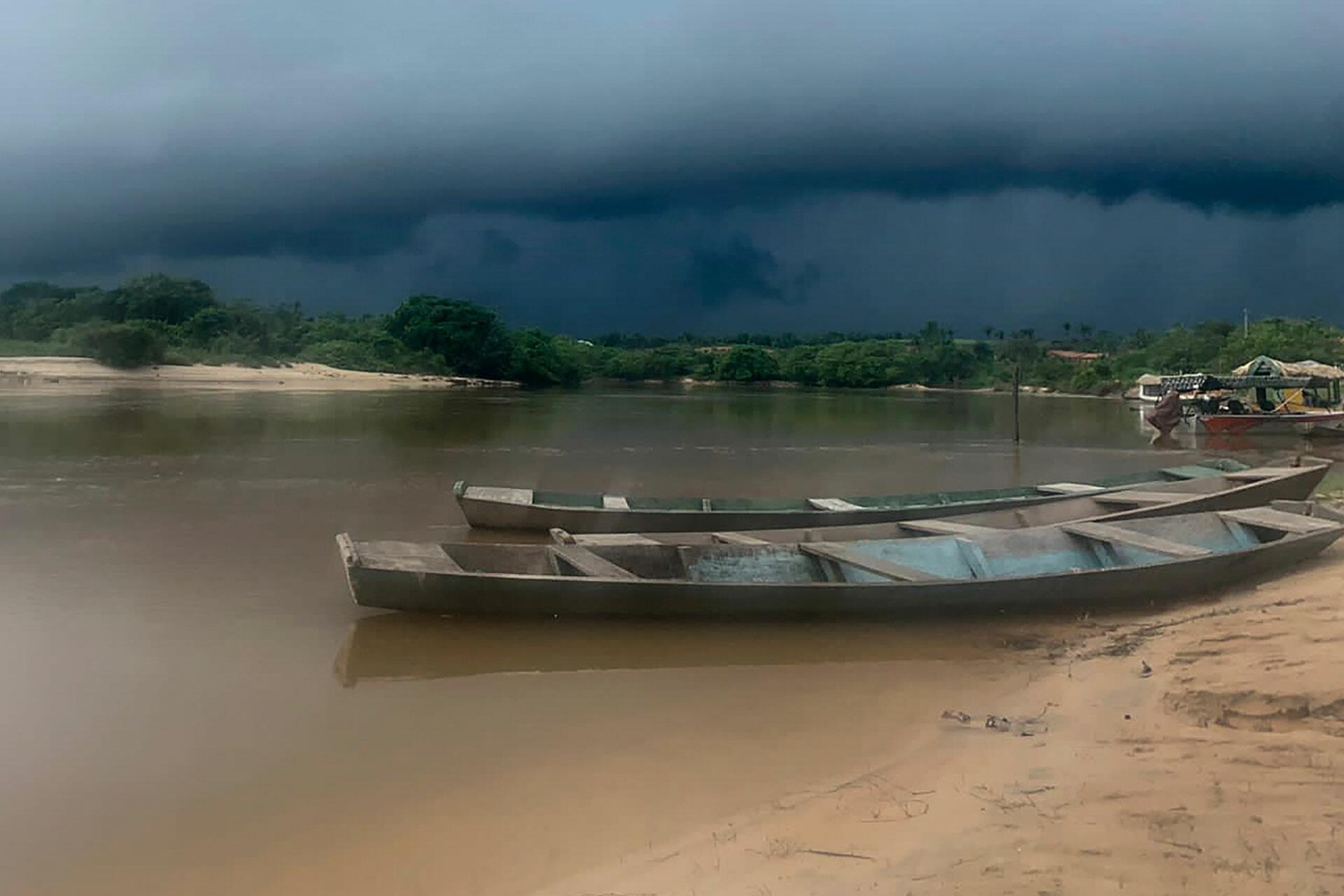
Banks of the Pindaré River in Alto Alegre do Pindaré. Photo: Soledad Barruti
Neto has got a static glowing smile. I agree to go with him for a ride along the river, to stop on the other bank and look at the jungle for a while. In his little boat with an engine, we move forward through these waters by ourselves. The wind gets colder, the village fades into the distance and he starts to tell me what is on the other side of the green that we can see.
“Farms and cows and cows and yet more cows. And then Bom Jardim, that’s the name of the place where I come from. Beforehand, I used to live on a plantation, a farm”.
He tells me about all the things that he had. Beans, tomatoes, fruits and chickens. He also had a pig but he sold it in order to come to the village. He says he was a rich man without being rich and that he never ever went to the supermarket. But he also says that he only sometimes misses it and that he does not regret moving here.
“Here I have more freedom,” he says.
We stop and get out of the boat and I stick my feet into the cool, clear water. He asks me the same questions that Regina asked a short while ago: how did I get here from so far away, why did I come and for how long will I stay. When I tell him that I will be staying for a few days, he offers to take me on a trip to somewhere else.
“To paradise. “
“What is it like? What’s there?”
“You have everything there. Alligators, boa constrictors, monkeys, birds and peccaries. There are jaguars too. And you wouldn’t believe what you find in the water: There are turtles, stingrays and loads of types of fish.”
“Loads,” he says, dragging his vowels with his black eyes all lit up like someone who is watching gold fall from the sky. He speaks of fish, of surubíes, and swears that they can be as much as two meters long. And at the end he says that paradise is found on indigenous land. He says it without any emotion, as if he were just talking about any old neighborhood, but I immediately understand what he is referring to: Neto is one of the invaders who is taking the Awa Guajás’ game.
“But you can’t enter indigenous land, it’s theirs,” I say.
“I go in, yes, I can. I know when they are not around and everything is there. Everything that is not here: there is hunting and fishing. They have all the jungle, that’s why, because the Indians are intelligent.”
“Do you like Indigenous people? “
“I don’t have anything against them, but they have got everything.”
Thick, heavy drops begin to fall. We get back in the boat. We don’t talk anymore. The rainy air is sweet like flowers and fruits.
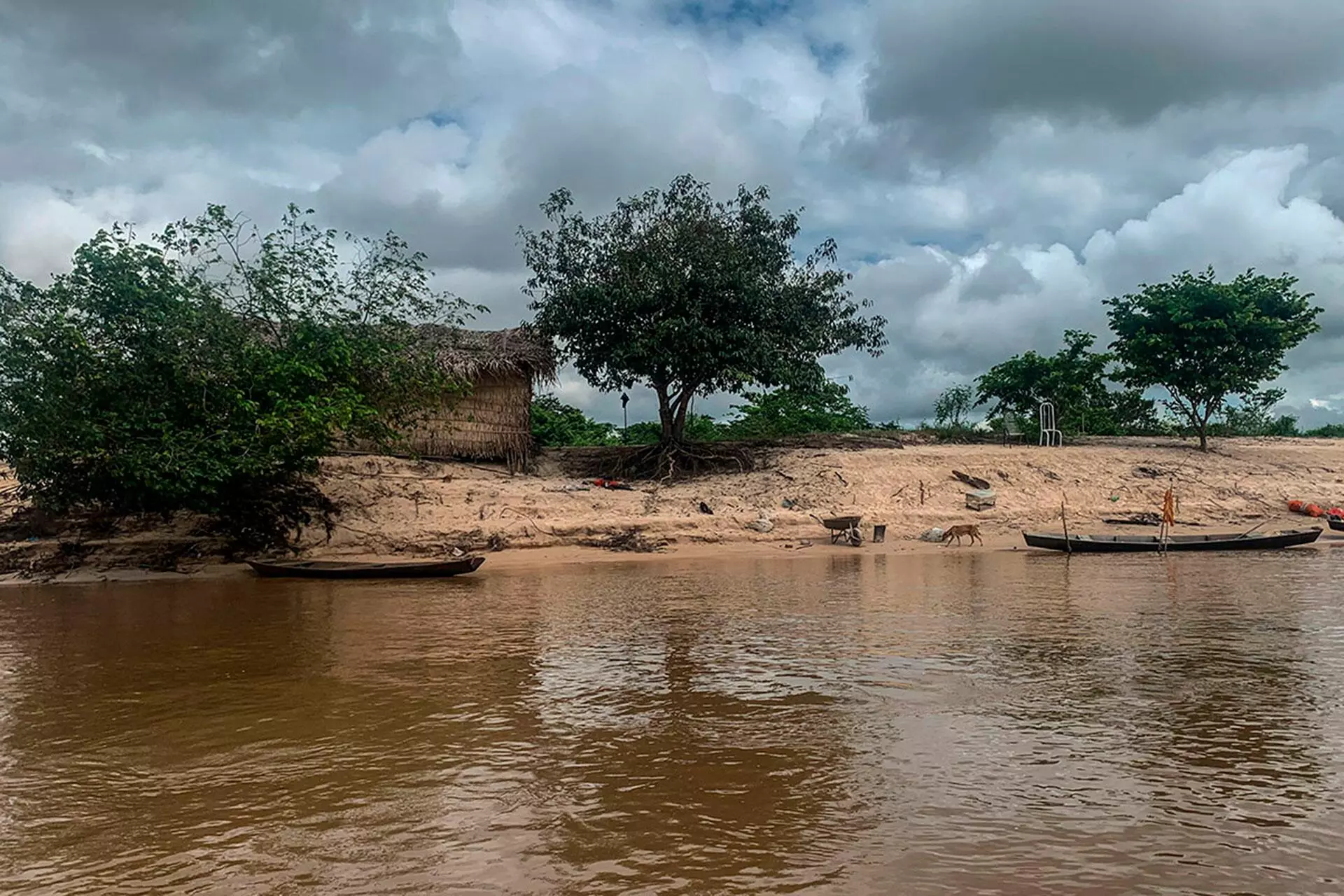
Photo: Soledad Barruti
The road to Caru Indigenous Land is only a short one in terms of the distance but it takes a long time to get there on account of the state of the road. There are holes and mud, and we have to cross the railroad tracks avoiding the cows.
We move forwards in silence. Every now and then we hear birds and cicadas. And every now and then the train goes by: the sound it makes is like blades on metal. All the freight cars are loaded with the iron ore that the mining company Vale extracts from that open sacrificial crater to make cars vehicles, girders, materials: things, things, things, things.
Maicon is a specialist at finding places to take pictures and videos, especially where you can see that the train is a monster. He doesn’t talk much about his experience working for the mining company, but I detect a subtle form of revenge in his dedication to denouncing it.
We skirt the little town called Auzilândia and go down to the tiny shore of the river in front of the village.
We are greeted by small yellow butterflies, then huge blue and silver ones. The river is the same one, the Pindaré, but here it is full of little bugs that perch on the surface and swirls that I assume are made by the breathing of the creatures that Neto told me about. And there are mosquitoes of a size I have never seen before.
The plan is for me to cross the river and for Maicon, who can’t swim, to stay on this side. Maicon shoots off the flare to let them know that we have arrived. The roar echoes through the jungle like a cannon shot. We take everything out of the trunk and wait.
Finally Arapio Awa Guajá turns up and swims across the river. To me he is just a teenager, but later I will find out that he was born in 1999 and that he has already got three children; so, for the Awa, he is a man. He speaks virtually no Portuguese at all, but we manage to understand each other with signs, smiles and sounds that we make in words that don’t even exist. We load up the canoe and cross the river.
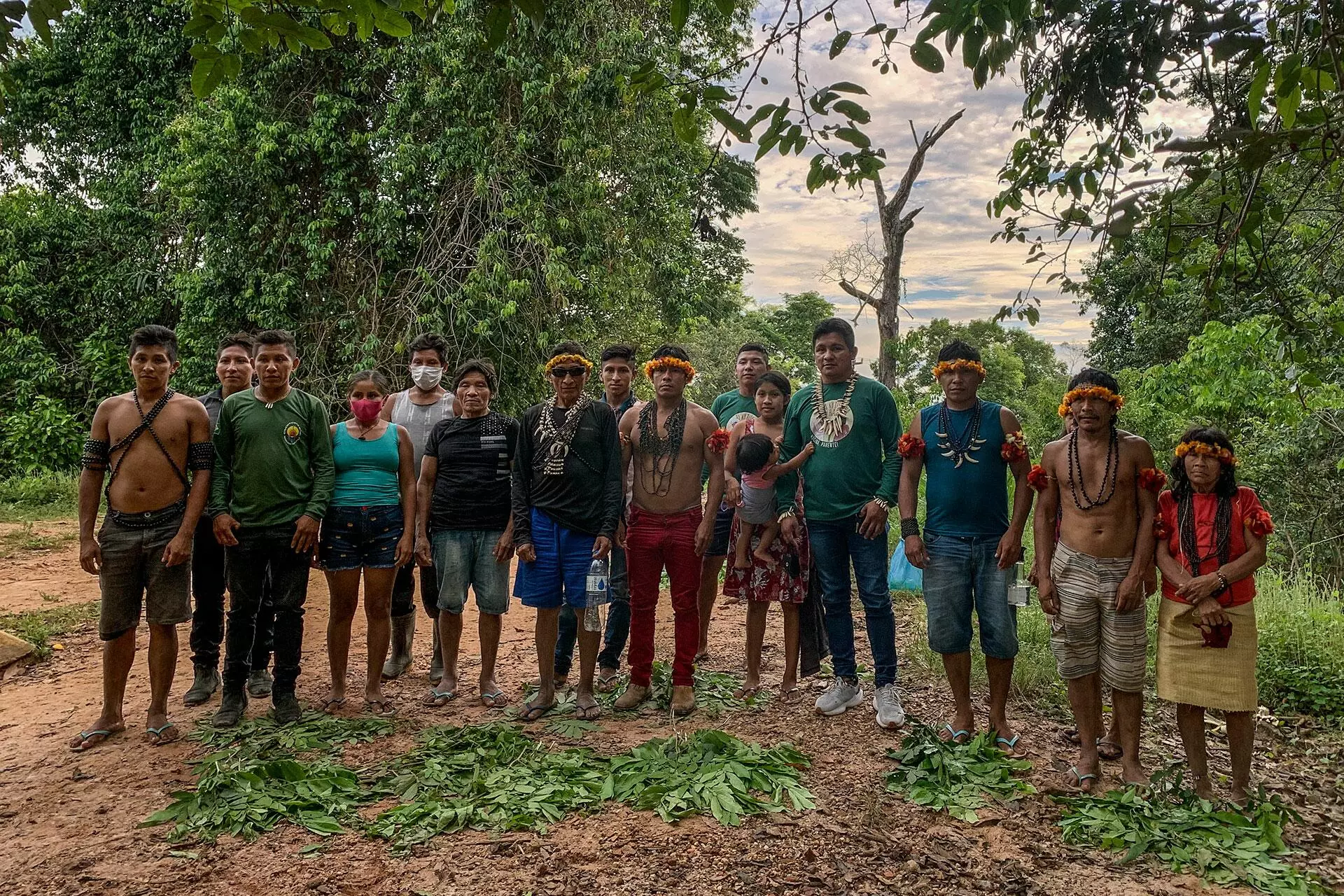
From left to right: Panỹxa’a Awa Guajá, Arawyta’ĩa Awa Guajá, Petua Awa Guajá, Ama-xika Awa Guajá, Piranẽ Awa Guajá, Hajkaramykỹa Awa Guajá, Irakatakua Awa Guajá, Arapio Awa Guajá, Amiria Awa Guajá, Takwarakỹa Awa Guajá, Takwariratỹa Awa Guajá, Itaxĩa Awa Guajá, Tatuxa’a Awa Guajá, Arakari’ĩa Awa Guajá, Takwarixika Awa Guajá and Jaharoa Awa Guajá. Photo: Soledad Barruti
On the other side, sixteen people are waiting for me. Panỹxa’a, Arawyta’ĩa, Petua and his wife Amaxika, as young as Piranẽ and Hajkaramykỹa. Irakata-kua, one of the older ones, turns up wearing sun glasses. One of the best hunters in the village, Takwarixika, and his wife Jaharoa, also came. And Arakari’ĩa, one of Hajkaramykỹa’s two wives. As well as the leaders there was also Hajkaramykỹa’s son Amiria, Itaxĩa and his wife Takwariratỹa, Tatuxa’a and his son Takwarakỹa. They all have the same surname, that of their ethnic group, the Awa Guajá.
Their outfits were specially designed for today, with feathers and necklaces. There is also Inês, who will be the interpreter, and children who look at us while bathing in the river. The greenery that surrounds us is the most intense that I have seen in my life.
The young people put mats made from green leaves on the ground for us to sit on. The men arrange themselves in front of me in a semicircle and one by one they introduce themselves. We are at the distance from each other that this virus continues to require and are wearing the usual face masks.
“Hi there, my name is Tatuxa’a Awa Guajá. I am the chief of the Awa village and I live here in the Caru Indigenous Land.”
Then Itaxĩa and Irakatakua introduce themselves. Irakatakua is the biggest one among them and is wearing glasses. He speaks softly and no one translates for him. Amiria is next, but he barely manages to say anything before we start to hear the noise of the train. The metallic sound grows louder and louder until it becomes an overwhelming presence, like a beast made of noise. Everyone looks at each other. They stop talking as the train from hell goes past. They remain silent for a time that felt like forever to me at that moment, but later, when I transcribed the recording, I found out that it was 12 minutes.
A repetitive, piercing sound like that, which forces us to stop talking, is known as a mind worm: a stimulus that gets into the ears and eats away at the brain. There is a wealth of scientific evidence showing that repetitive exposure to something like this affects the central nervous system and the brain, contributing to an increased risk of neuropsychiatric disorders such as strokes, dementia and cognitive impairment, neurodevelopmental disorders, depression and anxiety. Particularly sensitive problems in childhood: infants and children do not have the ability to anticipate stress factors of this type and suffer the consequences in a way that is still under study.
The Awa Guajá know what this noise does to the felines and the monkeys, to the birds and to the fish, to the river the banks of which are falling, making it a little bit wider with every passing day.
“The land is falling apart, the animals flee, they run away, and we cannot hunt and so we go hungry,” explains Tatuxa’a.
Ever since the train first came, life here has been worse for everyone.
Vale is supposed to pay compensation. The Mining Observatory (Observatório da Mineração) explains that the company pays a 3.5 percent tariff to the National Mining Agency (ANM). By law, since 2017, 15 percent of this amount should be set aside for those municipalities that have been affected by mining, i.e., those where there is a railroad, pipeline or any other sort of infrastructure. This amount is peanuts in relation to the estimated US$1.27 billion annual evasion.
When the noise stops, Inês suggests they tell their story. Tatuxa’a goes first. He has small, almond-shaped, black eyes and is wearing a blue T-shirt, an orange feather armband and a black seed necklace.
“This territory we are in is and was Awá territory. It used to all be one big forest, a lively jungle where there were no invasions. But when the Karaí, the whites, came, they tried to wipe out the territories. All this was told to me by my mother who came here one day fleeing from them and when she wanted to go back there everything was different.”
Tatuxa’a says ‘here’ and ‘there’ marking out with his finger everything that surrounds us, what still exists as jungle and what is nowadays town and road.
“All of this was Awa land,” he says.
“And the river could be crossed on foot,” adds Itaxĩa. But as the train goes by, the banks fall into the water and that’s why the river is getting wider and wider.
“My mother left and when she came back there was no more jungle,” Tatuxa’a continues. The Karaís came with their dogs. They would let them loose to attack us, they would try to divide us. My father also told me stories. All of this was our land.”
The Amazon region’s deforestation maps for Maranhão show this. Historically the Awa occupied the area from the upper Pindaré River (about 500 km south) to the lower Pindaré River where we are. It is a 720 km long river that coincides with the State of Maranhão’s Amazon region. Eighty percent of the forest that is no longer there was its territory. A mere 50 years ago the forest was still there. In the region where Itaxĩ was born just 35 years ago, there is no forest whatsoever left. Tatuxa’a’s parents are two orphans from the region where the Alto Turiaçu Indigenous Land is located. They lost their entire family and rebuilt their lives alone, joining other people who were in the same situation.
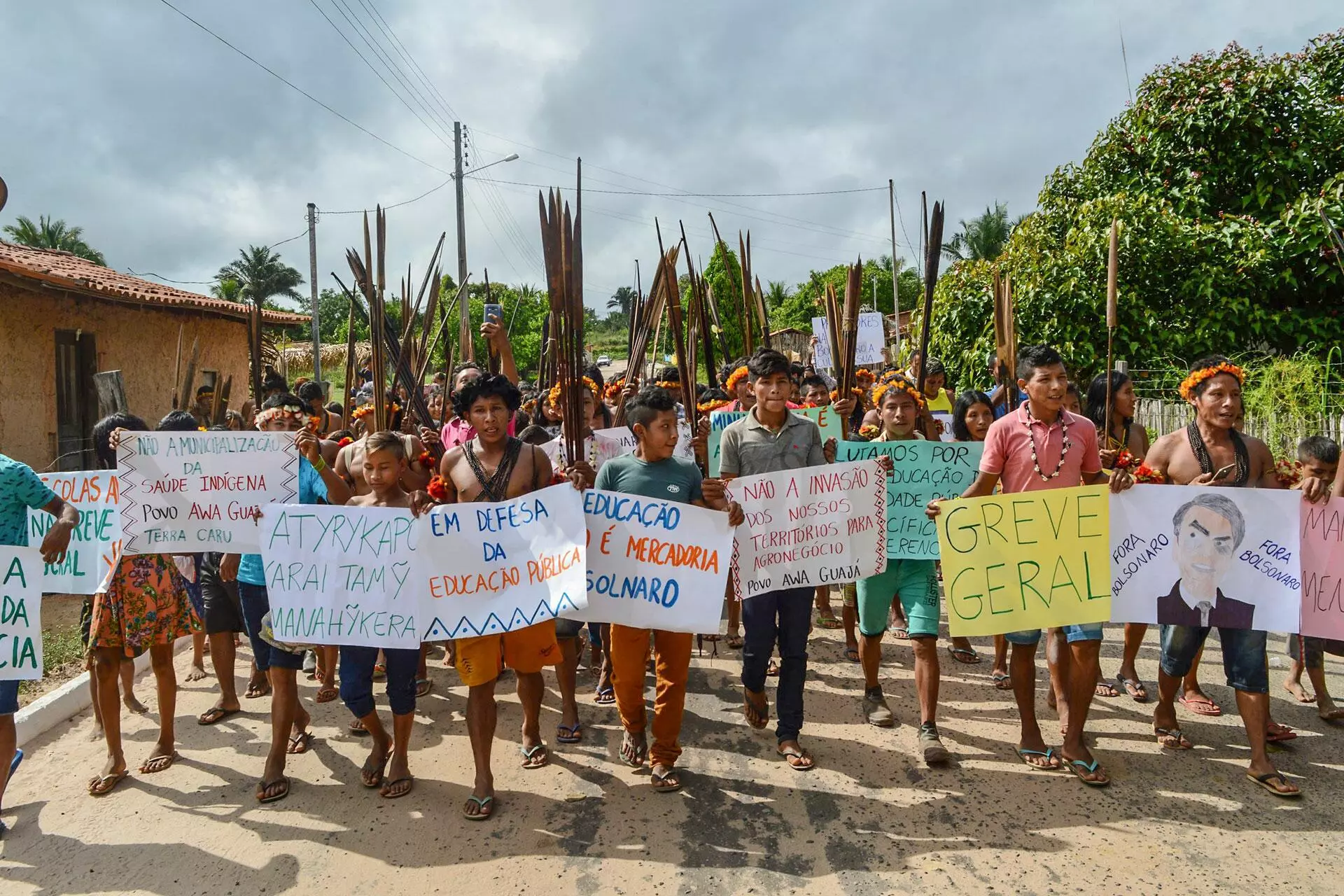
A demonstration by the Awa Guajá outside their land to demand better education. Photo: Awa Guajá
In the Awa language the way you say territory is the same as the way you say “what I know”. It’s the same word. It is by walking over the territory that they know, that they get to know each other and communicate and establish relationships among themselves and with the other feathered beings and mammals that inhabit the forest. On top of that, they experience a concept of impermanence that does not have the same linearity as we, the Karaí, do.
Since the first invaders entered in the 1970’s, the past and the present are plotted between the living jungle and the dead jungle. The violence that their grandparents and parents suffered returns to the present every time that they point to the destruction, when they mention the invaders and the mining company. The horror is happening now. But also, when they return to the living jungle, to those journeys, the experience of the present brings them to the possibilities that their relatives laid out for them.
Something curious also happens with the future. According to Awa beliefs, the dead do not completely leave the earth: their ancestors go to a heaven but come down to eat in the forest, to which they will also descend when they die. The future then swirls around in that timeless time of their babies and their old people, with their fragility and their need for care and relief.
“The people who attacked my grandmother also attacked my mother. The Karaí shot them from behind. They attack from behind, killing many people’s parents. The Karaí kill us.“
When Tatuxa’a finishes, Itaxĩa speaks.
“Someone discovered our relatives and forced them into contact. And then they brought the relatives here, forced them to stay still, to live in villages. That street, this road, everything was thick forest, as Tatuxa’a said. Some relatives got lost, they did not come with us. Then with those Karaí came the work mules. Even tractors were used to clear the land. The Indians could do nothing. All they could do was watch the land being cleared. And when they finished, the train began to run. The relatives then decided to go and see and it was all open space, there was nothing left. Then the train began to run, and brought the workers and many of our relatives ended up dying. A lot of them died of sadness because it is very sad to think about it and see how it was and what it’s like now. All that is left is this little piece where we are, which we are fighting for. But the destruction is increasing. They double the tracks, send more trains and say that this is progress. But what is the progress in having the jungle collapse? Nothing.”
Another train goes past. Once again we all fall silent. Now I feel the noise reverberating in my throat. The 16 indigenous people look to the front where I am but they see nothing. What exists shakes behind their backs. All that life that I and those who are like me do not even know, and which somehow, just by maintaining our way of living, we violate. A place where we could neither eat nor sleep, that we would need 200 lives to understand, although our whole life depends on it.
The Brazilian indigenous leader and philosopher Ailton Krenak says we live in times of ontological violence. In other words, in a time when everything is in place to destroy our capacity to live in poetry, in myth, in a creative and sacred uncertainty.
In the Awa villages, the end of the world has been snapping at their heels for 50 years: the old people are dying, the rituals are being neglected, false solutions are being brought in, even from the same demons who make their life this desperate. Such as the mining company Vale which on one day gives them courses, and then on another day gives them less money than it is supposed to or builds them tiny little houses. “We cannot put up our nets to sleep in these houses, we do not go in with our families, if we swing around we hit against the walls,” says Itaxĩa and some of them start laughing in a refreshing and knowing way. “Those people from Vale don’t understand anything at all. They also built a mud-brick house with a dome in the middle, but it rains inside. They told us that it would be cool and that we wouldn’t need a fan, but it’s not cool and in winter it’s very dangerous. They built this construction without consulting us as if it were for a generic Indigenous person, not for the Awa, without even knowing how we live or how we want to live.”
Vale was consulted as part of this research. With regard to their relationship with this territory that they use as a passageway and with those who live there, they stated: “We operate with a focus on constructive and mutually beneficial relationships, based on respect for cultural diversity and the rights of indigenous peoples and traditional communities. The company’s relationship with indigenous peoples is carried out by professionals who are experts in this matter, distributed throughout the territories that interact with these populations.”
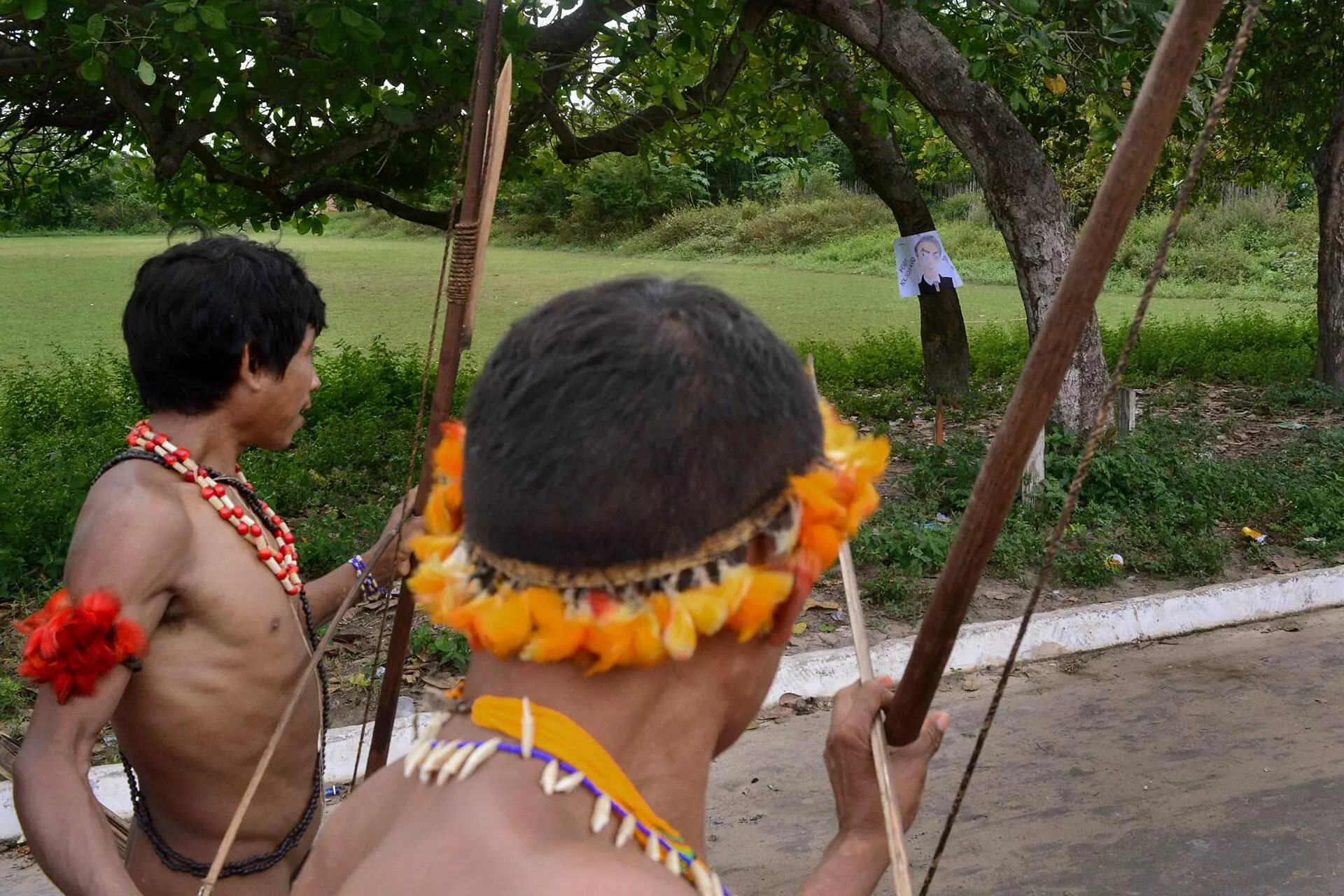
Awa Guajá indigenous people with self-made weapons. Photo: Awa Guajá
The State is considered another demon, allying itself with non-governmental organizations hired by Vale to “offset the effects” of its business, giving them domestic animals to raise and heavy machinery to till the land. To their way of thinking, if they grow crops, they do not have time to go hunting – their ancestral way of subsistence. Moreover, they have a worldview that includes bringing up wild animals, by including in their families very young monkeys and peccaries that wander around lost in the jungle. The women collect them, take them to their homes, take care of them, raise them and return them to the jungle at a later date. When the men go hunting, women go with them, pointing out the animals so that they will not be killed. “We don’t eat the ones that were nursed with our children,” says Amiria.
The government came into this village with chicken coops, pigpens, plant nurseries and beehives. It took up their time and forced projects on them, but never provided any sort of continuity for any of them. Nowadays all of those projects that the Awa Guajá spent their time on and were enthusiastic about have become things, garbage, forgotten remains.
There is also violence in this abandonment. In recent months the State has failed to meet its obligations and commitments. They interrupted the construction of the classrooms and assigned teachers who are not specialized in indigenous education. The Awa Guajá stopped attending classes and filed official complaints. Something similar has happened with health care: the State has just one doctor available for all the villages that are hundreds of kilometers apart.
Recently the government also changed its official liaison. It removed Daianne Veras Pereira, the coordinator of the Ethno-Environmental Front who was working with them, and in her place, without consulting the Awa Guajá, put in Elton Henrique Sá de Magalhães, a man with no experience with these peoples.
“The government put him in, but he does not know anything about our community and we do not accept him. We don’t want to have him here. He is not a good person. He was prosecuted and our community does not want him. There is a protocol of consultation and respect that was not met”, Tatuxa’a says.
A month later they told me by WhatsApp message that the new intermediary was forced out of the meeting with their arrows. And a month later they complained that Elton Henrique Sá de Magalhães had come on to their land without asking permission and had set fire to their meeting house.
On November 20th they told me that Covid-19 has come back into their villages again: it is as if the pandemic had ended, or as if what is left of this government wanted to exterminate them with what is left of this pandemic, the Awa Guajá do not have even the most basic protection materials – no masks, no hand sanitizers -, nor any rigorous mechanisms to ensure that infected officials do not enter their territory.
Inês suggests that we take a break for lunch. The women with babies and children come closer. We hand out the fruit and eat in silence.
When they meet each other’s eyes, when they speak in their language, when Inês and I hang back as if we were slightly invisible, we see them being themselves with the strength of what they are fighting for.
During the break Tatuxa’a shows me the handicrafts made by him. I buy a necklace and a wristband of little orange, blue, yellow and green beads. We take a picture together. I thank him for the trust that he has shown me and for making me feel welcome here. He is shy but I can tell he is happy that this is taking place.
The respite is short-lived. A small boat with a motor goes past in the river and sits in the middle of the water. It only goes off when the younger ones get closer to it. Then I tell them that I met an invader, not a member of a militia or a rancher, but a poor man who feels that the jungle is also his, that he has the right to enter, and I ask them what they think of them. Tatuxa’a answers:
“The Karaí have their rules, we have ours. You can’t fish here. We don’t go to the city to steal their things. If we did, the Karaí would attack us. We don’t attack them: we warn them, we tell them that we are doing surveillance, without fighting. This is how our work is being done. Our job is to be the guardians. Some of them listen to us and show us licenses and say: ‘I can fish anywhere’. They don’t respect anything. They don’t respect us. They cast their nets and don’t let the fish through. And we need fish. They kill the game and they take the fruit from our territory. And when we come face to face, they tell us ‘if you don’t want us to enter your lands, why do you come into the cities?’ But it is not the same thing. They are here stealing. We go into the city to buy something. If we were stealing in the city, don’t you think they would kill us? For sure they would. They come in, they hunt, and they don’t understand. White people don’t understand.”
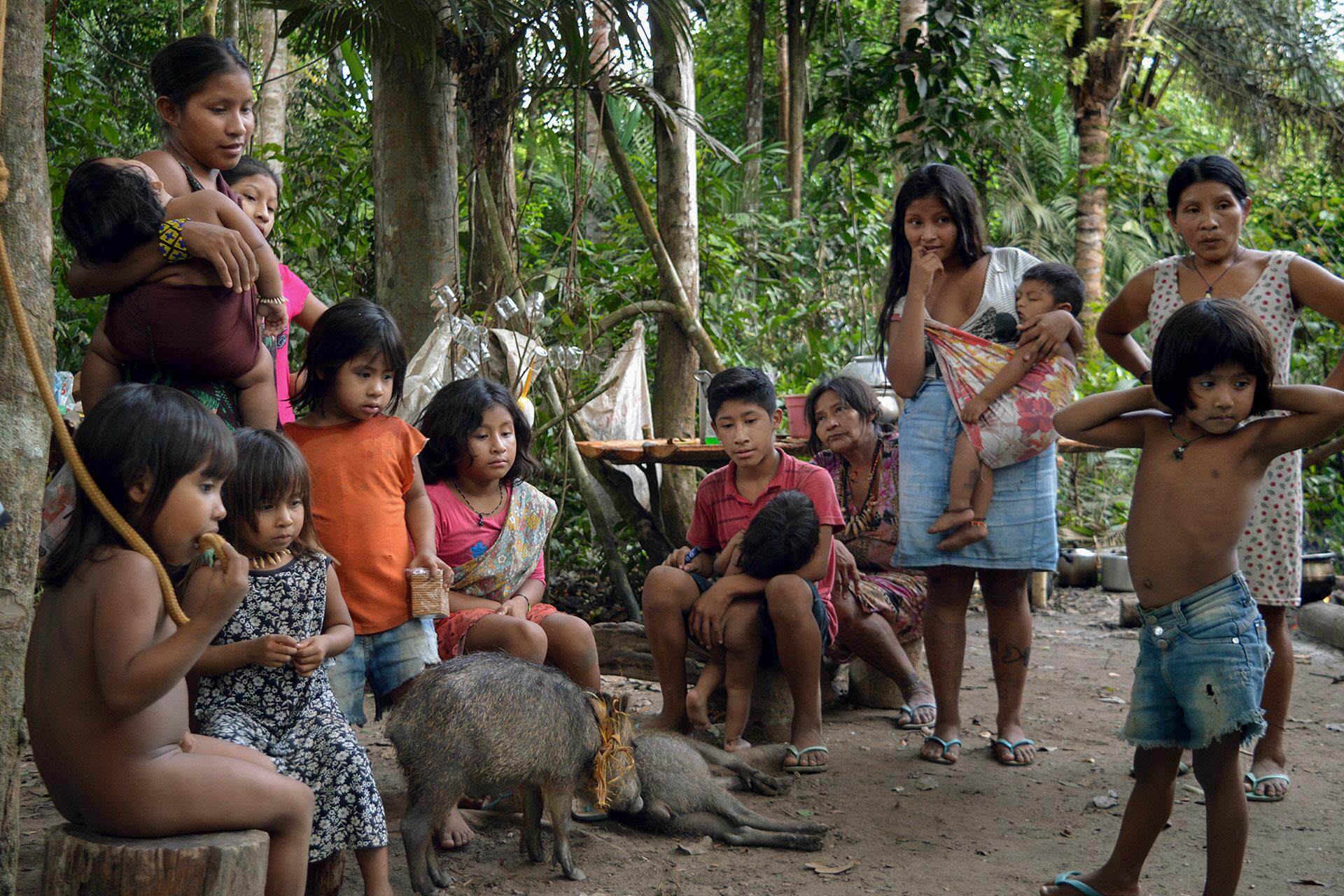
The indigenous Awa Guajá have a worldview that includes bringing up wild animals, by including in their families very young monkeys and peccaries that wander around lost in the jungle.
“However, we understand them”, says Itaxĩa. We understand that a lot of them don’t want to kill us. They just don’t have enough to eat. They have no money and in the city you don’t eat unless you have money. We understand that there are many poor people who need to feed themselves, with families to support. And they come onto indigenous land in order to do this. But that’s where the government has to give them something. Or Vale has to. Vale also destroys their territories. It also invades the villages that it passes through, it could also do some things to improve their lives.”
We say our goodbyes and take a group photo. Tatuxa’a asks what I do, what journalism is, what is the purpose of it.
“My job is to listen to you and tell your story so that more people know what is going on,” I answer. “I don’t know if it will be of any use, but I like to think that it will be.”
“Tell them that we are struggling and we live in hope. And that we, the indigenous Awa Guajá, protect the land to live, to take care of our children, to live longer, isn’t that right, relatives?” says Itaxĩa and everyone nods in agreement saying “that’s it, that’s it”.
“In this land which is ours there is fruit, acai, Brazilian fern trees, honey and water for our children, which is all we need. The trees, the land, our mother. If there is no forest, the river will end. The rainforest is what holds it all together. Water is what people drink, but without water people do not breathe. That is what we are protecting, right, relatives?”
“If people destroy the forest, there’s no way for us to live. Neither for them, although they don’t realize it.”
They carry on talking until the very last moment. It is their first experience with a journalist without any intermediaries, and they are eager to talk.
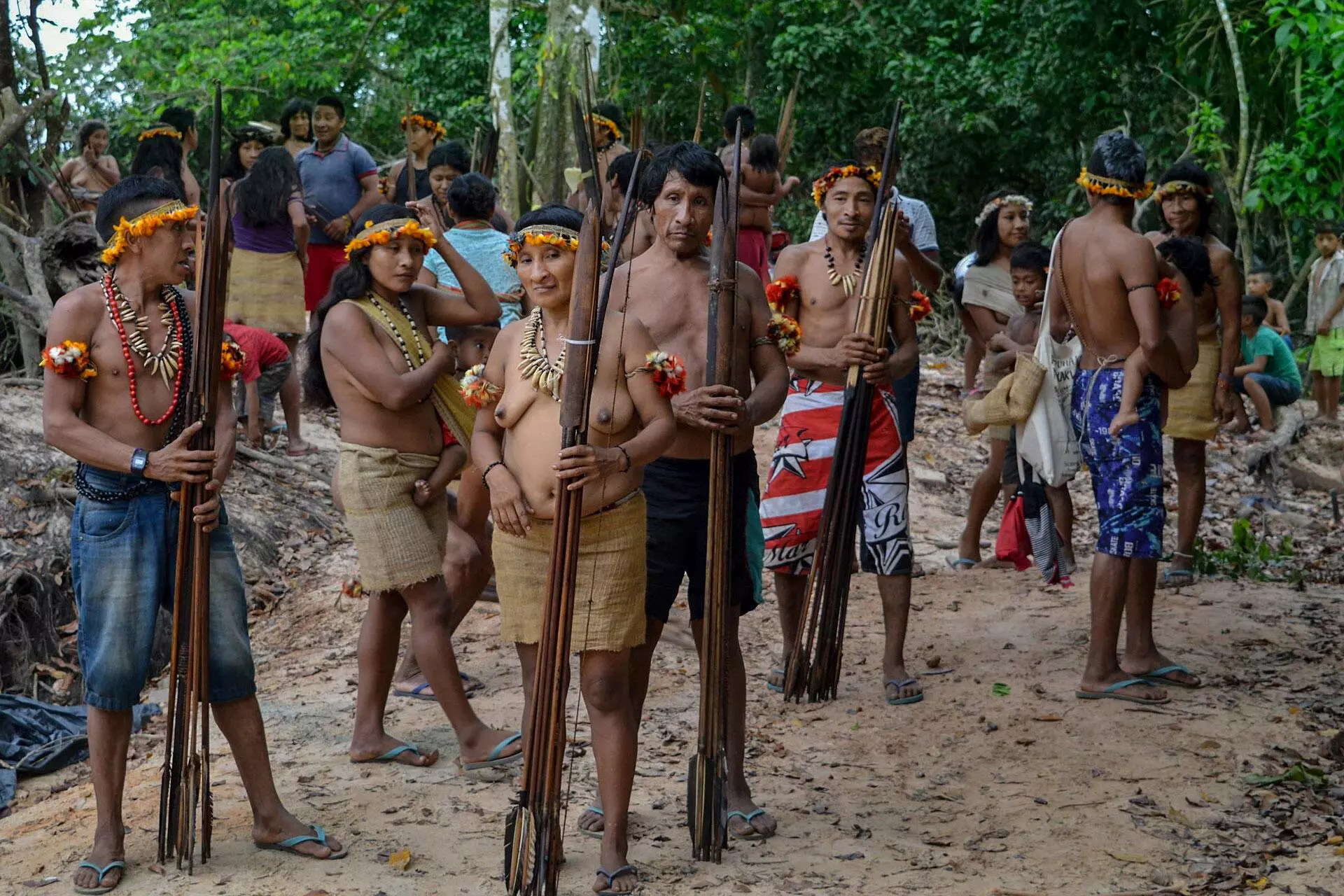
Os indígenas Awa Guajá costumam fazer seus protestos mais importantes interditando os trilhos do trem da Vale. Foto: Awa Guajá
Once again Arapio is chosen to take me back. He drives the boat as if there were no force against it. He crosses the river as if he were talking to it, as if he too were part of the water.
Back in the car I show Maicon the photos of the meeting.
“They liked the chickens I got”, he says, looking at one of the few shots I took: when the families were sharing the food. Although he is used to visiting the territories because of his work with Diogo, the human rights lawyer, he is surprised by the Awa Guajá people.
“The other Indians I know live more like us. You can see that they don’t.”
We stop in Auzilândia, the little town that’s on the other side of the road. There is a train station but there aren’t any hotels or restaurants, just a few stores. The heat is thicker here. Static, crushing. Suddenly I think it would be nice to have an ice-cold coconut.
“I’ll wait for you”, says Maicon, who does not detect here any of the dangers he senses every now and then in Alto Alegre.
I walk down the little streets that border the tracks. People peek out as I go past. I ask if there is anywhere that sells coconuts. They direct me to a corner and I knock on the green door.
A young woman who looks as though she’s just woken up comes out. She tells me to ask at the house next door out of which comes a very tall man whose skin is the color of the river. I repeat the coconut question and the bewildered look on his face makes me feel ridiculous. “Yes, I think there is one”, he says and invites me in.
Inside is his wife who is sitting in a red velvet armchair. It is a gloomy room full of old family photos: boys and girls of school age. The man goes to the back. The woman looks about 15 years older, her hair is all grey, her eyes shy between wrinkles. They have lived there since Auzilândia first began. Their children all left for São Luís.
“Life here is quiet, except for the train. The train used to come past from time to time, now it comes past all the time.”
“And what is the worst thing about the train?”
“A lot of things. The noise and the iron dust. There is a lot of sickness here. And there are no doctors. The train has ruined our lives.”
Then her husband comes back with a coconut and a machete. He says the coconut was high up, hands it to me freshly cut from the tree. I try to pay but they don’t accept it. He asks what I am doing in this area, so I tell him about my visit to the Awa Guajá.
“Ah, the Indians”, says the man. I hear the tone of that “ah” and a boundary has been drawn, a distance that’s impossible to cross. The Indians are fierce.
I ask him to cut the coconut open for me and he asks if he can take a picture of me.
“Nobody will believe me otherwise.”
We take a picture: him with his machete and his big hands looking like an old tree, and me with the coconut he gave me.
Night is about to settle over the streets of Auzilândia.
The sky is blue with just a golden light, the grass is long and pale, the cars are old and a skinny horse is resting nearby. Maicon is waiting for me at the end of the block. I reach for my notebook and write down the only thing I will be able to write for several months: Nothing is true except the jungle that is being killed.
Investigative reporting and text: Soledad Barruti
Photographs: Soledad Barruti and courtesy of the Awa Guajá community
Copy editing: Paula Mónaco Felipe
Photo editing: Miguel Tovar
This study was made possible with support from the Amazon Rainforest Journalism Fund in partnership with the Pulitzer Center
Translated by Mark Murray

